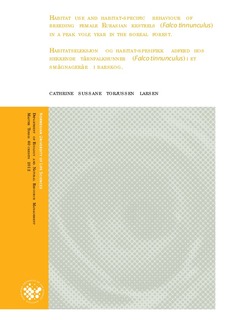| dc.contributor.advisor | Sonerud, Geir A. | |
| dc.contributor.advisor | Steen, Ronny | |
| dc.contributor.author | Larsen, Cathrine Sussane Torjussen | |
| dc.date.accessioned | 2012-09-14T09:55:05Z | |
| dc.date.copyright | 2012 | |
| dc.date.issued | 2012-09-14 | |
| dc.identifier.uri | http://hdl.handle.net/11250/187097 | |
| dc.description | Oppgaven klausuleres frem til 14.05.2017 for å forsikre at den kan publiseres i tidsskrifter. | no_NO |
| dc.description.abstract | I used radio telemetry to study the habitat use and habitat-specific behaviour of six female Eurasian kestrels (Falco tinnunculus). The field work was conducted in Trysil municipality, south eastern Norway, during the breeding season of 2011, a peak vole year. The study was conducted in a boreal forest area which also contained large areas with bog. A total of 374 plots were used in the analysis. I found that the female kestrels preferred using open habitats, edges and roads. A preference for bog without forest was found both through analysis of distances to habitats and habitats in buffer zones. The kestrels had an aversion regarding both distance to, and proportion of coniferous forests within buffers. Larger distances to water were preferred. Unproductive forest land and highest available ranked forest land were preferred in buffer zones, while lowest available ranked forest land, agricultural areas and settlements were avoided within buffer zones. Preferred habitat characteristics while perching was forested areas, the poorest and richest soil available, and forestry class II. The preference for bog is in accordance with previous findings in a low vole year. The aversion for agricultural areas is in contrast to most previous studies of the habitat use of the kestrel, but may be explained by the high vegetative cover in these areas during the field observations. | |
| dc.description.abstract | Radio-telemetri ble brukt til å studere habitatseleksjon og habitat-spesifikk adferd hos seks tårnfalkhunner (Falco tinnunculus). Feltarbeidet ble utført i Trysil kommune, i sørøst Norge, i hekkesesongen 2011, et smågnagerår. Studien ble utført i et barskogområde som også omfattet store myrområder. Totalt 374 observasjoner ble brukt i analysene. Jeg fant at tårnfalkhunnene prefererte åpent habitat, kantsoner og veier. Både gjennom analyse av avstand til habitat og andel habitat i buffer fant jeg en preferanse for myr uten skog. Tårnfalkene unngikk barskog, både med tanke på avstand og andel i buffer. Impediment og jord med høyest tilgjengelige bonitet ble preferert i buffersoner. Lavest tilgjengelige bonitet, jordbruksområder og bebyggelse ble unngått i buffersonene. Når tårnfalkhunnene hadde sittpost foretrakk de å sitte i skogområder, i lavest og høyest klassifisert bonitet og hogstklasse II. Preferansen for myr er i samsvar med tidligere funn i et dårlig smågnagerår. At tårnfalkhunnene unngikk jordbruksområder stemmer ikke overens med de fleste funnene i tidligere studier av habitatseleksjon hos tårnfalk, men kan muligens forklares av den tette vegetasjonen i disse områdene under feltobservasjonene. | |
| dc.language.iso | eng | no_NO |
| dc.publisher | Norwegian University of Life Sciences, Ås | |
| dc.subject | Falco tinnunculus | no_NO |
| dc.subject | Eurasial kestrel | no_NO |
| dc.subject | Habitat selection | no_NO |
| dc.title | Habitat use and habitat-specific behaviour of breeding female Eurasian kestrels (Falco tinnunculus) in a peak vole year in the boreal forest | no_NO |
| dc.title.alternative | Habitatseleksjon og habitat-spesifikk adferd hos hekkende tårnfalkhunner (Falco tinnunculus) i et smågnagerår i barskog | no_NO |
| dc.type | Master thesis | no_NO |
| dc.subject.nsi | VDP::Mathematics and natural science: 400::Zoology and botany: 480::Ecology: 488 | no_NO |
| dc.subject.nsi | VDP::Agriculture and fishery disciplines: 900::Agriculture disciplines: 910::Management of natural resources: 914 | no_NO |
| dc.description.embargo | 2017-05-14 | |
| dc.source.pagenumber | 63 | no_NO |
| dc.description.localcode | M-ECOL | |
